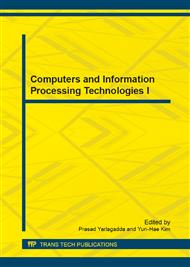[1]
A. Artikis, L. Kamara, F. Guerin and J. Pitt. Animation of Open Agent Societies, in the Proceedings of the Information Agents in E-Commerce symposium, AISB convention(2001), pp.99-109.
Google Scholar
[2]
Jeremy Pitt, Abe Mamdani, Patricia Charlton. The open agent society and its enemies: a position statement and research program. Telematics and Informatics. Vol. 18(2001), pp.67-87.
DOI: 10.1016/s0736-5853(00)00019-8
Google Scholar
[3]
Kosko B. Fuzzy Systems as Universal Approximators. IEEE Trans on Computers, Vol. 11(1994), pp.1329-1333.
DOI: 10.1109/12.324566
Google Scholar
[4]
W. X. Xie and S. D. Bedrosian. An information measure for fuzzy sets, IEEE Trans. Systems, Man and Cybernetics, Vol. 14(1984), pp.151-156.
DOI: 10.1109/tsmc.1984.6313278
Google Scholar
[5]
Audun Jøsang,Roslan Ismailand, Colin Boyd. A survey of trust and reputation systems for online service provision. Decision Support Systems, Vol. 43(2007), pp.618-644.
DOI: 10.1016/j.dss.2005.05.019
Google Scholar
[6]
Domenico Bianculli, Radu Jurca, Walter Binder, Carlo Ghezzi and Boi Faltings. Automated dynamic maintenance of composite services based on service reputation. Lecture Notes in Computer Science, Vol. 4749(2010), pp.449-455.
DOI: 10.1007/978-3-540-74974-5_42
Google Scholar
[7]
Florian Skopik, Daniel Schall, Schahram Dustdar. Modeling and mining of dynamic trust in complex service-oriented systems. Information Systems, Vol. 35(2010).
DOI: 10.1016/j.is.2010.03.001
Google Scholar
[8]
Wang, Zhi-Bing Li, Chang-Yun. Research on credit assessment based on trade behavior for e-commerce. Application Research of Computers. Vol. 27(2010), pp.945-947.
Google Scholar
[9]
He R,Niu JW,Zhang GW. CBTM:A trust model with uncertainty quantification and reasoning for pervasive computing[M]. Berlin: Springer, (2005), pp.73-89.
Google Scholar
[10]
Hu Bin, Liang Xikun. A Fuzzy Logic Based Credit Evaluation Model for Agent Society. Journal of Zhejiang University(Engineering Science), Vol. 42, No. 5(2008), pp.725-730.
Google Scholar
[11]
Li Shiyong. Engineering Fuzzy mathematics and its application. The Press of Haerbin University of Technology, 2004. (in Chinese).
Google Scholar
[12]
Takagi T. & Sugeuo M. Fuzzy identification of systems and its applications to modeling and control, IEEE Transactions on Systems man & Cybernetics, Vol. 15, Issue. 1(1985), pp.116-131.
DOI: 10.1109/tsmc.1985.6313399
Google Scholar


